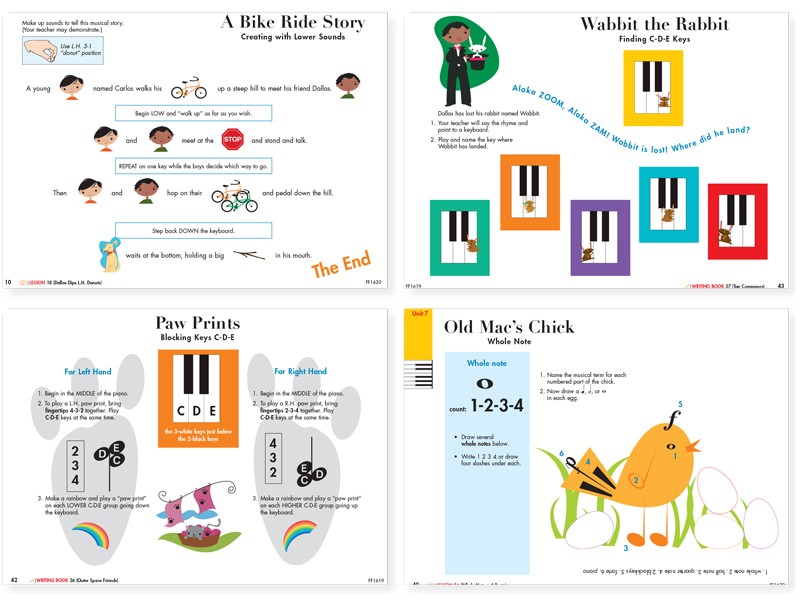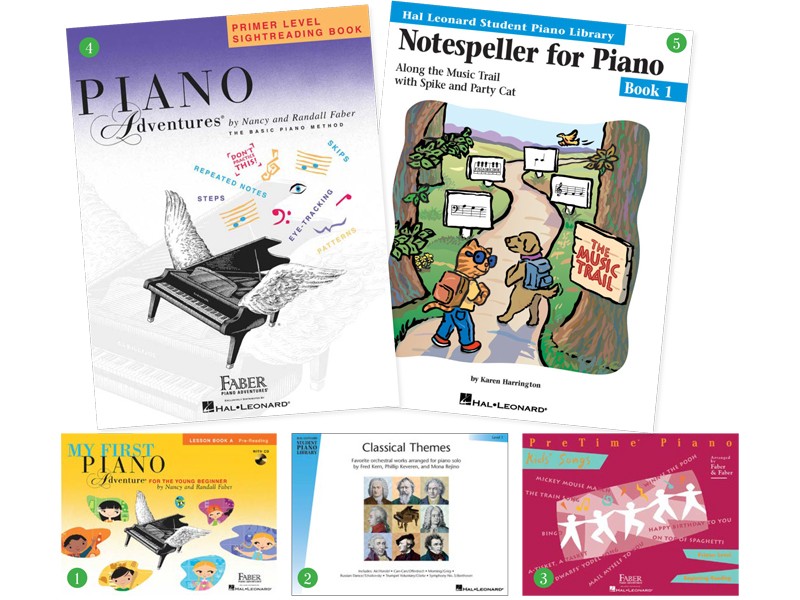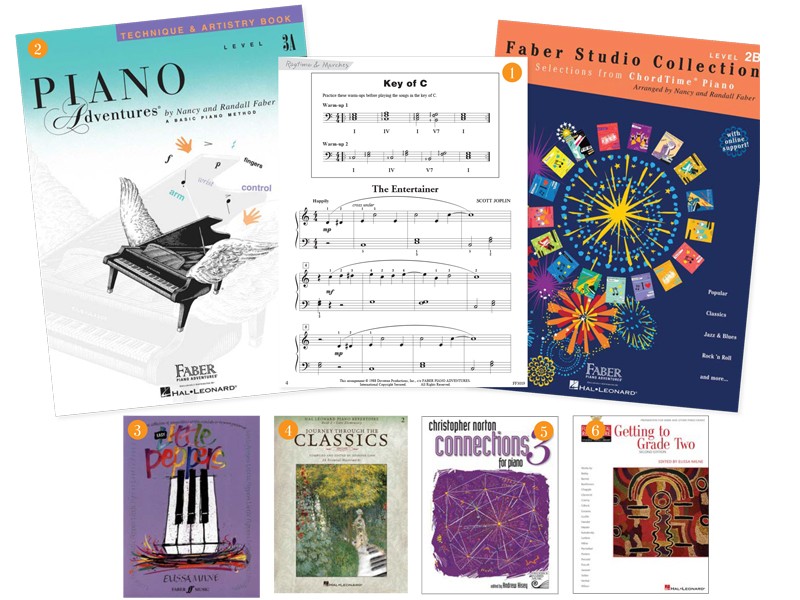Jack: The early beginner
I’ve got an early learner in my studio, Jack. He likes to be up and down from the piano, physically active and making interesting and quirky sounds. He likes to make aural stories and bounce from activity to activity. Now how do you choose resources for a child like this?
I needed something that would move slowly enough that he could physically develop the skills at a pace an active child of four and a half could manage. Something that was colourful, activity based, developed coordination, knowledge of numbers and letters and encouraged writing skills and tracking whilst reading, developed rhythmic skills on and away from the piano and stirred his musicality .

Jack started on My First Piano Adventures Lesson Book A (picture 1) and Writing Book A (picture 2). It covers all of the above criteria. He is engaged by the characters and particularly likes squashing ‘Tap’ the music bug, on each page! There are many duets for us to play in lesson and a fun accompanying CD for his parents to be able to help him at home. Primarily I appreciate the technique and sound focus of the book.
This is a pre-reading book. It doesn’t assume your student can already read and write. Jack has parental assistance to practice at home, so activities in the writing book such as “A bike ride story” work very well as they encourage him to develop firm fingertips, learn direction and the topography of the piano and associate sound with storytelling.

Students explore finger numbers (and reinforce RH/LH) throughout the both books. Jack has recently been playing Paw Prints learning C,D,E by cluster and likes making up which type of animal is making the paw print (kittens are soft and grizzly bears are loud). This is further reinforced by pieces encouraging topographic recognition of the keyboard- “Wabbit the Rabbit”, followed by a piece pulling together all of the skills at the end of the unit. Meanwhile the writing book has activities with letters and placement on the piano. This style of learning works well for Jack and suits his age, abilities, resources at home and learning style.
Ruby: The devourer
Another student, Ruby, came to me as a six year old. Ruby was the student who sometimes practiced, her reading and writing skills were still developing and she did not have support at home. Ruby also started with My First Piano Adventures (picture 1) and is able to read the instructions at home for herself. It moves at a pace that she could manage with the resources at her disposal. She was successful; she felt good about playing and was progressing well. Over several terms, her enthusiasm grew, as did her practice so to diversify her playing she also started pieces from Hal Leonard Student Piano Library Classical Themes (picture 2) and Pre Time Piano Kids’ Songs (picture 3). Ruby also benefited from having LOTS of music at her disposal. The Piano Adventures Primer Level Sight Reading book (picture 4) and Notespeller for Piano (picture 5) gave her plenty of material each week to get under her fingers. Ruby is now the student who benefits from having a large range of material at her level to devour each week, needing a variety of resources to develop her skills and sustain her interest rather than speeding through one method book only to begin another.

At the beginning of the school year, I inherited a ‘transfer student’. Cadence had already completed AMEB Grade One and had commenced working on pieces in Grade Two. According to Cadence, she had learned just the four songs required for her exam last year. That was it. For the whole year! Cadence was bored and uninspired. Most students in my studio complete the 40-piece challenge. It is a wonderful way to encourage them to explore more music, develop their skills, enjoyment, sight reading, repertoire list and musical vocabulary! After a discussion with Cadence’s parents about our new approach, I have introduced some new materials. I have specifically chosen resources that will be easier for her to begin with and explore a diverse range of genres such as the Faber Studio Collection Level 2B (Picture 1 below). This will also help play songs in the keys of the technical work she knows and give us an avenue to explore chords and theory. She has also commenced Piano Adventures Technique and Artistry Book Level 3A (Picture 2 below) for additional technique support and exercises.
Ruby is now the student who benefits from having a large range of material at her level to devour each week…
Cadence: The exam Cliché
Cadence is bright. She would no doubt be capable of forging ahead with the next exam, but it does her no favours as a musician. Pushing her quickly up the exam chain without learning a large amount of music is doing her a disservice. So this year Cadence will be studying music theory, sight reading, and exploring as much music as we can from books including: Easy Little Peppers by Elissa Milne (picture 3), Journey Through the Classics Book 2 (picture 4), Chopin Waltzes for Easy Piano, Christopher Norton Connections For Piano Book 3 (picture 5) and Getting to Grade Two (picture 6). Before we select the repertoire for her Grade Two exam, Cadence will have developed her knowledge and skills and will have completed many pieces at a Grade Two level. And hopefully Cadence will also be enjoying her music making a whole lot more.

You can read more from Carly at creativepianoprofessional.com
